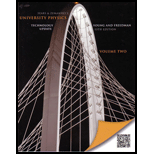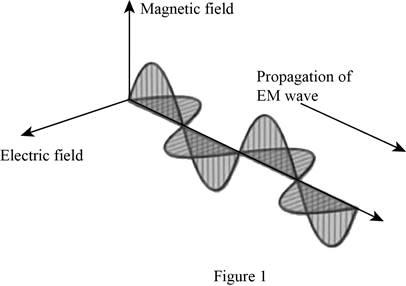
University Physics with Modern Physics Technology Update, Volume 2 (CHS. 21-37)
13th Edition
ISBN: 9780321898098
Author: Hugh D. Young
Publisher: PEARSON
expand_more
expand_more
format_list_bulleted
Question
Chapter 32, Problem 1DQ
To determine
The direction of electromagnetic wave by measuring electric and magnetic fields.
Expert Solution & Answer
Explanation of Solution
The propagation direction of electromagnetic wave is perpendicular to vectors of electric filed and magnetic field.
Assume direction of electric filed and magnetic field can be found at a point in a space. The direction of propagation wave can be found by taking cross product of electric filed and magnetic field

From figure 1, electromagnetic wave direction is perpendicular to the vectors of electric filed and the magnetic field. Therefore, direction of electromagnetic wave is opposite to direction of
Conclusion:
Therefore, direction of electromagnetic wave is opposite to direction of
Want to see more full solutions like this?
Subscribe now to access step-by-step solutions to millions of textbook problems written by subject matter experts!
Students have asked these similar questions
1) A light source is emitting light with 800nm wavelength in a double slit experiment. The separation between the slits is0.01 m and the screen is 5 meters away.a) Find the angle for the fifth and the sixth constructive interferencesb) Find the distance between the third constructive and the third destructive interferences on the screen
A light is passing through a small circular hole with radius 0.002 meters. The third destructive resonance is attheta=0.004 radians. Find the wavelength of the light. Find the angle for the third constructive resonance.
A circular capacitor has 6mm radius. Two parallel plates are 2mm apart. Between the capacitors magnetic field is B=410^-2 Tesla in theta direction at a given time. Calculate the displacement current and change in electric field at thatmoment
Chapter 32 Solutions
University Physics with Modern Physics Technology Update, Volume 2 (CHS. 21-37)
Ch. 32 - Prob. 1DQCh. 32 - Prob. 2DQCh. 32 - Prob. 3DQCh. 32 - Prob. 4DQCh. 32 - Prob. 5DQCh. 32 - Prob. 6DQCh. 32 - Prob. 7DQCh. 32 - Prob. 8DQCh. 32 - Prob. 9DQCh. 32 - Prob. 10DQ
Ch. 32 - Prob. 11DQCh. 32 - Prob. 12DQCh. 32 - Prob. 13DQCh. 32 - Prob. 14DQCh. 32 - Prob. 1ECh. 32 - Prob. 2ECh. 32 - Prob. 3ECh. 32 - Prob. 4ECh. 32 - Prob. 5ECh. 32 - Prob. 6ECh. 32 - Prob. 7ECh. 32 - Prob. 8ECh. 32 - Prob. 9ECh. 32 - Prob. 10ECh. 32 - Prob. 11ECh. 32 - Prob. 12ECh. 32 - Prob. 13ECh. 32 - Prob. 14ECh. 32 - Prob. 15ECh. 32 - Prob. 16ECh. 32 - Prob. 17ECh. 32 - Prob. 18ECh. 32 - Prob. 19ECh. 32 - Prob. 20ECh. 32 - Prob. 21ECh. 32 - Prob. 22ECh. 32 - Prob. 23ECh. 32 - Prob. 24ECh. 32 - Prob. 25ECh. 32 - Prob. 26ECh. 32 - Prob. 27ECh. 32 - Prob. 28ECh. 32 - Prob. 29ECh. 32 - Prob. 30ECh. 32 - Prob. 31ECh. 32 - Prob. 32ECh. 32 - Prob. 33ECh. 32 - Prob. 34ECh. 32 - Prob. 35ECh. 32 - Prob. 36ECh. 32 - Prob. 37ECh. 32 - Prob. 38ECh. 32 - Prob. 39ECh. 32 - Prob. 40ECh. 32 - Prob. 41ECh. 32 - Prob. 42ECh. 32 - Prob. 43ECh. 32 - Prob. 44ECh. 32 - Prob. 45ECh. 32 - Prob. 46ECh. 32 - Prob. 47ECh. 32 - Prob. 48ECh. 32 - Prob. 49ECh. 32 - Prob. 50ECh. 32 - Prob. 51ECh. 32 - Prob. 52ECh. 32 - Prob. 53ECh. 32 - Prob. 54ECh. 32 - Prob. 55ECh. 32 - Prob. 56ECh. 32 - Prob. 57ECh. 32 - Prob. 58E
Knowledge Booster
Similar questions
- A light source is incoming with 30 degrees with the normal force to an equilateral prism made out of a material withn=1.2 and it exits the prism. Draw the ray diagramarrow_forward1 Cartpole System Analysis The cartpole system (Fig. 1) consists of a cart of mass M moving along a frictionless track, and a pendulum of mass m and length 1 pivoting around the cart. The mass of the pendulum is assumed to be equally distributed along the rigid rod. The system is actuated by a horizontal force F applied to the cart. m Ө X F M Figure 1: Cart-pole as the combination of a cart and a pendulum. 1.1 Tasks 1. Draw the free-body diagram of the pendulum and cart, showing all forces acting on them. Note: Point the reaction force Fx as the coupling force between the pendulum and the cart in positive x-direction in the free-body diagram of the pendulum.arrow_forwardA light beam with intensity I=40W/m^2 passes through two polarizers. First polarizer makes 30 degrees with the y-axis and the second one makes 40 degrees with the x-axis. Find the final intensity as it exits both polarizers fora) Original beam is umpolarized b) Original beam is polarized in x direction c) Original beam is polarized in y-directonarrow_forward
- Find the critical angle between ruby and glass. Ruby has n=1.75 and glass has n=1.5Draw an approximate raydiagram for a beam coming 5 degrees less than the critical anglearrow_forwardCalculate the value of the force F at which the 20 kg uniformly dense cabinet will start to tip. Calculate the acceleration of the cabinet at this force F. Must include the FBD and KD of the system. Ignore friction.arrow_forward1) A 2.0 kg toy car travelling along a smooth horizontal surface experiences a horizontal force Fas shown in the picture to the left. Assuming the rightward direction to be positive and if the car has an initial velocity of 60.0m/s to the right, calculate the velocity of the car after the first 10.0s of motion. (Force is in Newtons and time in seconds). (Hint: Use impulse-momentum theorem) F 5.0 10 0 -10arrow_forward
- 3) Two bumper cars of masses 600 kg and 900 kg travelling (on a smooth surface) with velocities 8m/s and 4 m/s respectively, have a head on collision. If the coefficient of restitution is 0.5. a) What sort of collision is this? b) Calculate their velocities immediately after collision. c) If the coefficient of restitution was 1 instead of 0.5, what is the amount of energy lost during collision?arrow_forwardThe rectangular loop of wire shown in the figure (Figure 1) has a mass of 0.18 g per centimeter of length and is pivoted about side ab on a frictionless axis. The current in the wire is 8.5 A in the direction shown. Find the magnitude of the magnetic field parallel to the y-axis that will cause the loop to swing up until its plane makes an angle of 30.0 ∘ with the yz-plane. Find the direction of the magnetic field parallel to the y-axis that will cause the loop to swing up until its plane makes an angle of 30.0 ∘ with the yz-plane.arrow_forwardGive a more general expression for the magnitude of the torque τ. Rewrite the answer found in Part A in terms of the magnitude of the magnetic dipole moment of the current loop m. Define the angle between the vector perpendicular to the plane of the coil and the magnetic field to be ϕ, noting that this angle is the complement of angle θ in Part A. Give your answer in terms of the magnetic moment mm, magnetic field B, and ϕ.arrow_forward
- Calculate the electric and magnetic energy densities at thesurface of a 3-mm diameter copper wire carrying a 15-A current. The resistivity ofcopper is 1.68×10-8 Ω.m.Prob. 18, page 806, Ans: uE= 5.6 10-15 J/m3 uB= 1.6 J/m3arrow_forwardA 15.8-mW laser puts out a narrow beam 2.0 mm in diameter.Suppose that the beam is in free space. What is the rms value of E in the beam? What isthe rms value of B in the beam?Prob. 28, page 834. Ans: Erms= 1380 V/m, Brms =4.59×10-6 Tarrow_forwardA 4.5 cm tall object is placed 26 cm in front of a sphericalmirror. It is desired to produce a virtual image that is upright and 3.5 cm tall.(a) What type of mirror should be used, convex, or concave?(b) Where is the image located?(c) What is the focal length of the mirror?(d) What is the radius of curvature of the mirror?Prob. 25, page 861. Ans: (a) convex, (b) di= -20.2 cm, i.e. 20.2 cm behind the mirror,(c) f= -90.55 cm, (d) r= -181.1 cm.arrow_forward
arrow_back_ios
SEE MORE QUESTIONS
arrow_forward_ios
Recommended textbooks for you
 College PhysicsPhysicsISBN:9781305952300Author:Raymond A. Serway, Chris VuillePublisher:Cengage Learning
College PhysicsPhysicsISBN:9781305952300Author:Raymond A. Serway, Chris VuillePublisher:Cengage Learning University Physics (14th Edition)PhysicsISBN:9780133969290Author:Hugh D. Young, Roger A. FreedmanPublisher:PEARSON
University Physics (14th Edition)PhysicsISBN:9780133969290Author:Hugh D. Young, Roger A. FreedmanPublisher:PEARSON Introduction To Quantum MechanicsPhysicsISBN:9781107189638Author:Griffiths, David J., Schroeter, Darrell F.Publisher:Cambridge University Press
Introduction To Quantum MechanicsPhysicsISBN:9781107189638Author:Griffiths, David J., Schroeter, Darrell F.Publisher:Cambridge University Press Physics for Scientists and EngineersPhysicsISBN:9781337553278Author:Raymond A. Serway, John W. JewettPublisher:Cengage Learning
Physics for Scientists and EngineersPhysicsISBN:9781337553278Author:Raymond A. Serway, John W. JewettPublisher:Cengage Learning Lecture- Tutorials for Introductory AstronomyPhysicsISBN:9780321820464Author:Edward E. Prather, Tim P. Slater, Jeff P. Adams, Gina BrissendenPublisher:Addison-Wesley
Lecture- Tutorials for Introductory AstronomyPhysicsISBN:9780321820464Author:Edward E. Prather, Tim P. Slater, Jeff P. Adams, Gina BrissendenPublisher:Addison-Wesley College Physics: A Strategic Approach (4th Editio...PhysicsISBN:9780134609034Author:Randall D. Knight (Professor Emeritus), Brian Jones, Stuart FieldPublisher:PEARSON
College Physics: A Strategic Approach (4th Editio...PhysicsISBN:9780134609034Author:Randall D. Knight (Professor Emeritus), Brian Jones, Stuart FieldPublisher:PEARSON

College Physics
Physics
ISBN:9781305952300
Author:Raymond A. Serway, Chris Vuille
Publisher:Cengage Learning

University Physics (14th Edition)
Physics
ISBN:9780133969290
Author:Hugh D. Young, Roger A. Freedman
Publisher:PEARSON

Introduction To Quantum Mechanics
Physics
ISBN:9781107189638
Author:Griffiths, David J., Schroeter, Darrell F.
Publisher:Cambridge University Press

Physics for Scientists and Engineers
Physics
ISBN:9781337553278
Author:Raymond A. Serway, John W. Jewett
Publisher:Cengage Learning

Lecture- Tutorials for Introductory Astronomy
Physics
ISBN:9780321820464
Author:Edward E. Prather, Tim P. Slater, Jeff P. Adams, Gina Brissenden
Publisher:Addison-Wesley

College Physics: A Strategic Approach (4th Editio...
Physics
ISBN:9780134609034
Author:Randall D. Knight (Professor Emeritus), Brian Jones, Stuart Field
Publisher:PEARSON